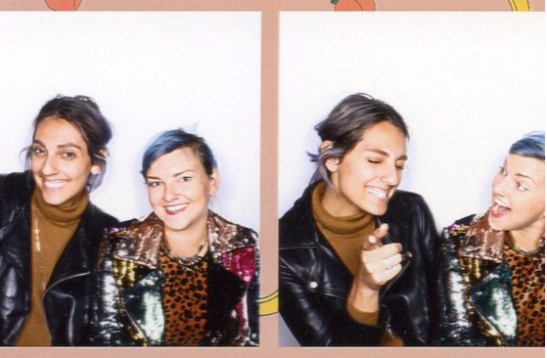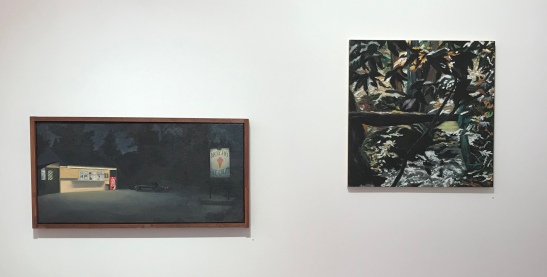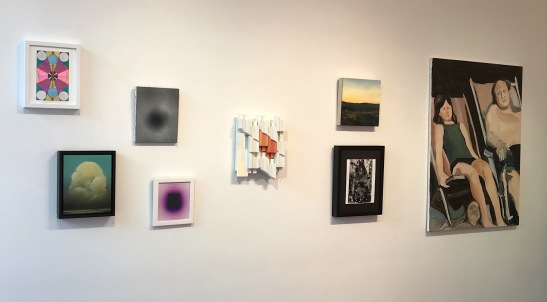440 Gallery | Brooklyn NY
Shop talk, answers to your FAQs, and a peek behind the scenes of an artist-run fine art gallery in Park Slope
A behind-the-scenes look at “Light” our juried theme exhibition
The summer goes by so fast! Our 2019 Theme Show Light closed yesterday, and we sat down with our two guest jurors. 440 Gallery Director Amy Williams asked jurors Lauren Hirshfield & Kat Ryals, co-directors of Paradice Palase some questions about their process. Enjoy the banter back and forth, stay cool, and see you in September!

That’s Lauren on the left, Kat on the right.
AW: The theme of light is pretty open ended, what was your thought process during the selection of artworks? What were you looking for in the curatorial process?
Kat: My first thought when it came to the topic of light was to find works that furthered our understanding of what light can mean. So naturally during the curatorial process, I was drawn to works that explore darkness (low light), diffusion of light (smoke/clouds), cinematic or mood lighting, and conceptual/symbolic interpretations of light.
Lauren: When going through each jury round, I definitely considered how the submissions engaged the theme in nontraditional or unexpected ways. I was drawn most to works that had light and shadow expressed through color value, or that utilized light as a tool and not as a subject or focus. The final two rounds of jurying really came down to finding the ideal grouping that had a conversation with each other. We were quickly drawn to the spiritual/mystical thoughline in some of the works and then radiated out curatorially from there.

Michelle McElroy, Dairy Joy, 2017 (left), Patty Neal, Into the Woods, 2018 (right)
AW: Was this theme a good topic? Were you surprised by the artwork that came in?
Kat: Well, I have two thoughts. I think it’s a good topic because it is broad in how both juror and artist can interpret the topic. It’s definitely a great theme for a juried exhibition. However, “light” is also a common theme for art exhibitions—many artists explore it in some aspect in their work. For me this means that an exhibition covering a recurring topic can risk being cliche or less than thrilling. However, we were conscious of that concern and really wanted to challenge our interpretation of what “light” could be.
I wasn’t surprised by the artwork that came in, actually. I expected a broad range and that was what we received and I was very pleased by that because it gave us a lot of freedom in how to shape the exhibition. The quality of work that did come through, whether it was more traditional or conceptual, was outstanding and we found it to be incredibly difficult to whittle it down to around 30 artists. It was nice to have a co-juror for this reason—I was able to weigh decisions with another person.
Lauren: I always enjoy open call shows that have a broad theme to consider. It allows a larger pool of artists to be considered and leaves them the task of shaping their submissions accordingly. “Light” is a great theme because there is so much that can be unpacked despite the single word prompt. I was expecting a wide range of submissions, and certainly a lot of photography, so I wasn’t too shocked by what we initially received. We really dug into everyone’s submissions, and followed up by browsing through websites and social media pages to get a better picture of each artist practice as a whole. It was pleasantly surprising to receive submissions from artists on all levels, novice and professional, as well as those who explored strange topics and subjects. I think it was those surprises that pushed our curatorial selection into a darker, weirder, tongue-in-cheek place.

Kat: “We were very sad to exclude some of the artists in the end, but it came down to tightness of the curatorial vision and also some space issues.”
AW: Kat, you’re also a visual artist. When you’re curating shows, do you find yourself attracted to work that is in a similar vein to the art you make? If so, how do you free yourself from that inclination, or do you?
Kat: I know that I certainly am attracted to works that are engaged in similar themes and aesthetics as my own, but I approach curating from a problem-solving standpoint and choose works that to me best represent a theme or topic. Sometimes I’ll even vouch for artists or works that are not my personal taste, especially when I recognize that someone is doing meaningful work. I’ll curate them in for the sake of clarity or thoroughness in coverage of the theme, as well as to achieve cohesiveness or even balanced diversity in the work.
Growing up, all I did was paint from childhood through high school, but veered off into a photography major in college. Then in grad school I moved into sculpture and installation. So I’m really drawn to and understand all sorts of mediums, and I really enjoy curating from a theme based or narrative approach and then building out the show from there. So, I do think I do a pretty good job of curating objectively. That said, in the future I intend to put together shows that are based around themes and issues I cover in my own work and for those exhibitions, I will tend to incorporate artists that have similarities to my own work. [see Kat’s website]
AW: Lauren, is it safe to assume that as a curator, you’re always on the hunt for new artists? Where do you look to discover artists when you’re working on a new project?
Lauren: Yes, I’m always on the lookout for new artists! It’s sort of a problem sometimes because I discover new artists nearly every day and fall in love with their work instantly and want to find ways to curate them and there’s only so many shows I can organize at once! I make a point to go to gallery openings often. I try for one a week at least. It’s definitely how I find out about new artists, or network with ones that I’ve been following online already. Speaking of, I use Instagram as a major source of discovery. I create bookmark folders for different categories or to get an immediate visual draft of show ideas. And I follow major arts hashtags too! I definitely look at hashtags to find artists and artwork specific to mediums, location, themes, genres, etc. So if you’re good at posting on social media, use relevant hashtags and make a point to tag yourself when posting, or have people tag your work when they post about you. I pay attention to all of that very regularly.
-

Wen-Han Change, Strange World, 2018
AW: I know there were many artworks that made the first cut, but due to the gallery size, I asked you to edit down pretty tightly. Do you have any advice or words of encouragement for the artists that did not make it into the show?
Kat: Yes, we were very sad to exclude some of the artists in the end, but it came down to tightness of the curatorial vision and also some space issues. I’m not sure what additional advice to give artists who ultimately didn’t make the cut, because it wasn’t that the work wasn’t strong enough to be placed in the show but more so that maybe it didn’t fit as well with the majority of the selection pool. Some advice I would give:
* Be conscious of gallery size when applying to open calls.
* If you are submitting something on the larger size, make sure that it really responds well to the theme and is a particularly strong piece.
* Having a unique take on a theme is a plus, but it can’t be too much of a stretch. Sometimes the only way to know if you are submitting the best work to an open call is to ask someone else for an opinion before you submit. I also strongly advise that whenever submitting an application for a show or a proposal, have at least two people review it for you. I like to have another artist or arts professional take a look, and also someone who is not as familiar with the art world because they can give you an objective and honest opinion. This way you can get perspective from both someone in your own field and an outsider, and based on their responses you can see if your application text and images are clear and make sense. If they don’t see the connection or don’t understand your statement, the juror isn’t going to spend time trying to figure it out either.
Lauren: There were certainly some tough decisions when making the final cut. We had around 15 additional works in the round before our final selections, and we still ended up selecting over 30 artists which is the most included in an open call show for 440 Gallery thus far I believe. So you can see we struggled to whittle down for sure! There truly were some outstanding submissions that didn’t make it into the show, and ultimately, selections came down to the three sub themes that we made curatorial decisions to follow through on. Some advice I would give:
* Don’t let your rejection one year discourage you from submitting again the next. Open call shows very much depend on the juror/jury panel selected, so your work may resonate more with one person and less with another.
* We know that applying to open calls can be overwhelming and exhausting, so a smart first step for best use of your time during open call season is to make sure your work makes sense with the space! Do the research and look at the exhibition history of the gallery and of the jurors. Do they work with specific artists/genres/mediums? If your work doesn’t seem to fit the curatorial style of the gallery and/or jury, it may already be a stretch to have your work considered. The costs of applying to open calls can add up fast, so if you can take those steps to be finite with your choices, you’ll be that much more confident in your applications.
* That being said, don’t be afraid to take a risk here and there! If you think your work or practice relates to the gallery’s programming but isn’t an obvious fit with the theme, think about the secondary and tertiary themes in your work and if those can relate to the theme in some way. Often times I will select work despite my innate curatorial sensibilities because the artist concisely and effectively explained how it relates to the theme.

Lauren: “Often times I will select work despite my innate curatorial sensibilities because the artist concisely and effectively explained how it relates to the theme.”
AW: What one thing has shaped the work that you do?
Kat: As a curator, the experience of leaving school two times (undergrad and grad) has shaped what I do. I was often left feeling that there wasn’t a lot of support for emerging artists, and it was unclear how I could begin my career professionally and navigate the art world. In school I had resources and support, and then I felt that I was just kicked to the curb—it didn’t help that choosing to live in the south after graduation often felt like entering an arts and culture desert. During and after graduate school, I was really interested in figuring out how to get the general public to enjoy and engage with art, rather than it being treated as this insular and enigmatic world. After finishing my Museum Education studies I serendipitously met Lauren, another enthusiastic curator/artist, and she shared my feelings about the art world. Together, we helped push ahead to challenge the established systems of the art world and work to make it a better field for its workers. We also tried to make it a more valuable aspect of culture to the public. We’re basically working towards developing new models that support young, underrepresented or emerging artists and also providing resources to them to help them to be successful. This is also in tandem with coming up with ways to engage general audiences in the arts, which we think occurs through interactive and experiential programming.
Lauren: My curatorial practice grew out of years of testing the waters with freelance jobs at galleries, with independent curators, and with an arts nonprofit. What I enjoyed most while working in each of those positions was helping artists select work and organize their shows! So it was a natural next step to start curating independently. I didn’t want to work in a gallery when I graduated college, there was something about the contemporary gallery scene at the time that felt cold and unwelcoming, and I couldn’t see myself fitting into that mold. I think the landscape is changing now for gallerists and curators of what a gallery can be, and how people want to consume art and culture. So I’ve found my way into running a gallery now, but it’s on my terms. I can give space and visibility to artists that I believe in and want to see succeed, and that feels good. I also found my niche in the NYC scene after years of jumping around different sectors so I think that helps, when creatives can have an “art family” to lean on for support and encouragement. When I can build artists up, and their exhibition history and sales history isn’t the only “currency” for valuing them, I feel like I’ve done my job.

Lauren: “A smart first step for best use of your time during open call season is to make sure your work makes sense with the space! Do the research and look at the exhibition history of the gallery and of the jurors.”
AW: Do you have any projects coming up? Tell us about them!
Kat: We’ll be back in the fall with our Artist Curated Cinema at Bizarre Bar and our ArtBrewt workshop series at Bridge and Tunnel Brewery. We’re also cooking up exhibitions for September and October, and will have our first annual Member’s show in November. Note: there’s still time to sign up for a membership and be included in this year’s show! Find more information here.
Lauren: Paradice Palase has a pop-up in August that I organized, featuring photography from two college classmates of mine. Margaret Murphy and Keavy Handley-Byrne are good friends and their photo practices relate closely with one another despite living on opposite sides of the country. The show should be a fun one. It opens August 15 at our project space in Bushwick (1263 Bushwick Ave, Brooklyn). For myself, I will be upstate in September for a week-long critic/curator residency at the Wassaic Project. I will be writing a deep-dive interview and review of one artist’s work; it will at least be up on the Palase blog by mid September if I don’t get it pitched to an online magazine! So stay tuned for that.
Coming up in the fall: check out Amy William’s interviews with two exhibiting artists from “Light.” Valeria Divinorum, working with glass and crystals to explore the intangible properties of light. George Horner: working in several mediums that are usually not considered “high art” materials (Silly Putty, neon, plastic toy soldiers, etc.)
